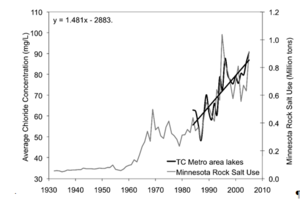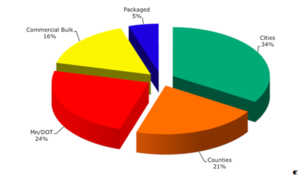
Difference between revisions of "Winter Parking Lot and Sidewalk Maintenance Manual"
| Line 44: | Line 44: | ||
*About 75% of Minnesotans rely on groundwater for drinking water. The MPCA has found 30% of the shallow monitoring wells, often found in urban areas, have exceeded the state standard for salt levels. As water moves from shallow to deeper aquifers, the salt contamination could penetrate sources of drinking water ([https://www.pca.state.mn.us/sites/default/files/wq-am1-06.pdf MPCA 2013]). | *About 75% of Minnesotans rely on groundwater for drinking water. The MPCA has found 30% of the shallow monitoring wells, often found in urban areas, have exceeded the state standard for salt levels. As water moves from shallow to deeper aquifers, the salt contamination could penetrate sources of drinking water ([https://www.pca.state.mn.us/sites/default/files/wq-am1-06.pdf MPCA 2013]). | ||
*The average salt use in the TCMA based on purchasing records is 349,000 tons per year ([https://conservancy.umn.edu/bitstream/handle/11299/115332/pr503.pdf?sequence=1 Sander et al. 2007]). | *The average salt use in the TCMA based on purchasing records is 349,000 tons per year ([https://conservancy.umn.edu/bitstream/handle/11299/115332/pr503.pdf?sequence=1 Sander et al. 2007]). | ||
| + | |||
| + | |||
| + | [[File:Concentration of lake chloride inTC lakes and rock salt purchases by MN.PNG|right|thumb|300 px|alt=This graph illustrates the Concentration of lake chloride in Twin City lakes and rock salt purchases by State of MN|<font size=3>Concentration of lake chloride in Twin City lakes and rock salt purchases by State of MN</font size>]] | ||
| + | |||
| + | [[File:Distribution of road salt use in Twin cities area.PNG|right|thumb|300 px|alt=This graph illustrates the Distribution of road salt use in Twin cities area|<font size=3>Distribution of road salt use in Twin cities area</font size>]] | ||
Revision as of 16:42, 1 February 2016
Background Information
Good Business Choices
Customer service is the key to success. Best Management Practices (BMP) keep parking lots and sidewalks safe and also reduce environmental impacts. Educating customers on the proper methods of snow removal and ice control (and of the value of this approach) can create a good and long-standing relationship.
Customers want reliable service. Providing a well-planned and well-executed winter maintenance program will have a positive impact. Using the latest technologies will increase the abilty to provide reliable service.
Customers want to hire educated winter maintenance professionals. This maunal will provide the necessary information to increase staff knowledge on the best practices for winter maintenance.
Using the right amount of material at the right time, will save time and money.
Certification in Smart Salting is a good reflection on the professional and the organization.
Customers and the public want safe parking lots and sidewalks. Understanding the materials, weather and application rates, provide a head start on controlling icy, slippery parking lots, and sidewalks.
Clean and neat parking lots and sidewalks are important to the public. By using less material and increased winter sweeping, pedestrians will track less material into buildings and there will be less damage to flooring. Proper snow storage makes debris removal in the spring easier. Covered storage of deicers will reduce loss of material, protect water, and is more aesthetic. Using BMPs and lower application rates will keep parking lots and sidewalks looking neat.
Customers also want affordable snow and ice control. The use of sophisticated chemicals and equipment may require a larger budget up-front; however, these costs can be balanced by reduced on-going costs. Reducing the need for sweeping, floor and rug maintenance, parking lot striping, and snow and ice maintenance time will allow for cost savings.
Minnesotan’s value water resources and the protection of lakes, streams, and wetlands is important. Educating customers how sustainable winter maintenance protects water resources is necessary.
Using less material is an effective approach to protecting our water resources. It is difficult to recover salt or sand once applied.
Water and Environmental Impacts
- Only 2.5% of all of the water on this planet is freshwater (not saltwater). Of that, less than 1% is available for use. The majority of the freshwater is frozen in the glaciers (Freshwater Crisis n.d.).
- Water is recycled over long periods of time. There is a limited supply of water on this planet. Water is reused, recycled and dispersed as illustrated below from the Minnesota Department of Natural Resources (DNR), “Healthy Rivers: a Water Course” (Healthy Rivers 2004).
Chloride concentrations are increasing in many surface waters and groundwater across Minnesota.
- In the Twin Cities Metropolitan Area (TCMA), of surface water bodies tested, 39 are on the draft 2014 impaired waters list for chloride exceedances and 38 more are found to be at high risk as of July 2015. (MPCA 2015). Salts (chloride) dissolve in water and move with the water to nearby lakes, streams, and wetlands and also infiltrate into groundwater.
- Chloride is virtually a permanent pollutant that does not degrade and cannot be removed from surface waters. Once in the water, it continues to accumulate in the environment over time.
- Salt water is heavier than freshwater and may sink to the bottom of lakes. This may cause chemical stratification of the lake and loss of or changes in lake turn over (Stefan et al. 2008).
- Thirty percent of the 270 shallow aquifer monitoring wells tested in the TCMA exceeded the state chloride standard. (MPCA 2013).
- About 75% of Minnesotans rely on groundwater for drinking water. The MPCA has found 30% of the shallow monitoring wells, often found in urban areas, have exceeded the state standard for salt levels. As water moves from shallow to deeper aquifers, the salt contamination could penetrate sources of drinking water (MPCA 2013).
- The average salt use in the TCMA based on purchasing records is 349,000 tons per year (Sander et al. 2007).

